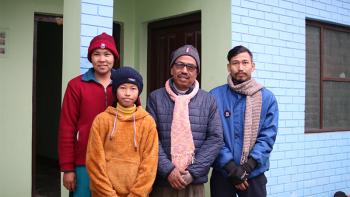Quick Facts
Individuals served in FY22: 213,695
- Through new construction – 2,150
- Through incremental building – 215
- Through repairs – 510
- Through market development – 181,610
Volunteers engaged in FY20: 823
Other facts:
- Population: nearly 30 million
- Life expectancy: 66.6 years
- Unemployment rate: 11.4%
- Population living below poverty line: 25.2%
Source: World Factbook
Habitat for Humanity in Nepal
Habitat Nepal, established in 1997, has served over 70,000 households and built a network of valued local partners through which it implements its housing programs. Since 2015, reconstruction has been the primary focus of Habitat Nepal, directing funding and technical support to the earthquake-affected central region, followed by shelter initiatives in the flood-devastated lowlands of the East and West. In line with its new strategic plan, Habitat Nepal will develop programs, build institutional capacity and raise funds with tithing Habitat affiliates in the U.S. to make the transition from a primarily disaster-reconstruction operation to a portfolio of projects that address Nepal’s shelter needs more comprehensively and sustainably.
The housing need in Nepal
Nepal is among the least developed countries in the world, with a quarter of its population living below the international poverty line. In the rural and peri-urban areas where Habitat for Humanity Nepal works, most families live on insecure day wages as farm or construction laborers. The marginalized ethnic groups in Koshi Province and Madhesh Province in the east and Far-western Province in the west live in huts with walls of untreated bamboo or wood plastered with mud and cow dung. The roofing is typically made of mud tiles, hay, or plastic sheets. During the monsoon season, mud floors become damp or moldy, affecting families’ health, children’s education, and the huts’ life span. Rats, snakes, and insects that get in also endanger their safety and health. The national census in 2021 showed that about 45% of the 6.6 million families in Nepal are living in inadequate and substandard houses not meeting technical standards.
How Habitat addresses the need in Nepal
Since 2005 Habitat Nepal has been implementing its programs through local partners who share the vision of safe, decent shelter for all Nepali families. These local nongovernmental organizations and microfinance institutions multiply Habitat’s impact through their broad outreach to marginalized communities, leveraged loan capital for housing, and holistic development approaches. Together with its partners, Habitat Nepal specializes in the following services:
• Promoting safe shelter designs and technologies.
• Researching and developing market-based housing solutions.
• Advocating with local and federal government entities to direct resources to address the shelter needs of highly vulnerable groups.
• Mobilizing international volunteers and local youth to raise awareness and support for housing needs in Nepal.
Unlocking government funds for housing
Habitat Nepal partners with the Government of Nepal to unlock multiple government housing funds for low-income families, marginalized groups, and disaster-affected people. Habitat Nepal provides technical support, mobilizes partners and community members, and helps the most vulnerable through top-up financial support to reduce home construction costs.
Improving access to finance for housing
Access to finance is a major obstacle to home ownership among low-income families. Habitat Nepal collaborates with microfinance institutions to strengthen their housing loan products. This enables many low-income rural families who are underserved by existing financial markets to access housing credit more easily. Training in financial and digital literacy helps women utilize financial products for their economic empowerment.
Promoting women’s land rights
The National Census, 2021 reveals that about 75% of women don’t possess either housing or land in their name. The Government of Nepal has stepped up efforts in recent years to promote gender equality in its property laws. However, the rights of a married woman to claim her husband’s property remain unclear unless her name is registered in the title. Habitat Nepal is promoting the joint registration of both husbands’ and wives’ names in property titles, or any occupancy rights documents issued by the government. This protects women from being evicted from their marital home in the event of separation, divorce or their husbands’ deaths,
Strengthening market systems for affordable housing solutions
Habitat Nepal promotes affordable housing solutions utilizing locally available, environmentally friendly materials such as bamboo through a market-based approach engaging private sector actors. Through orientation, and awareness-raising, we encourage families to adopt affordable and environmentally sustainable building materials such as bamboo, compressed stabilized earth blocks and “rat-trap” wall systems. Habitat Nepal’s housing designs are also featured on the government’s list as being suitable for earthquake and flood-prone areas in the country.


